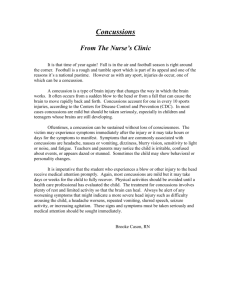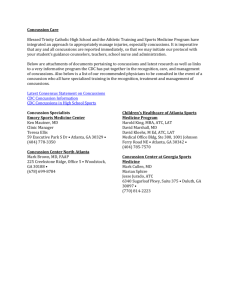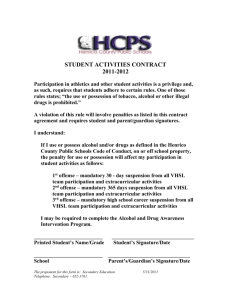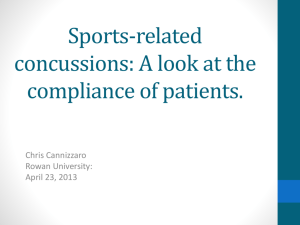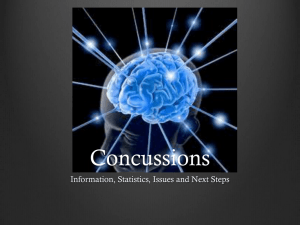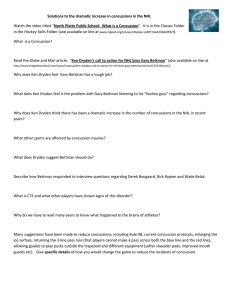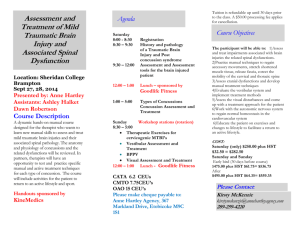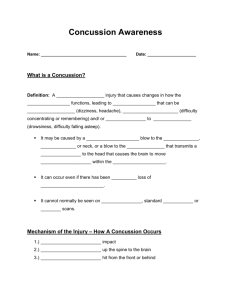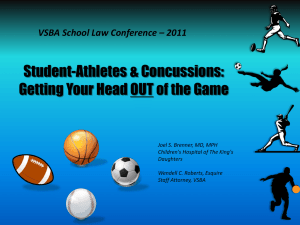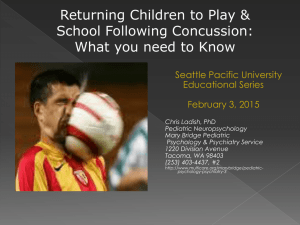Sports related concussion: Assessment and management
advertisement
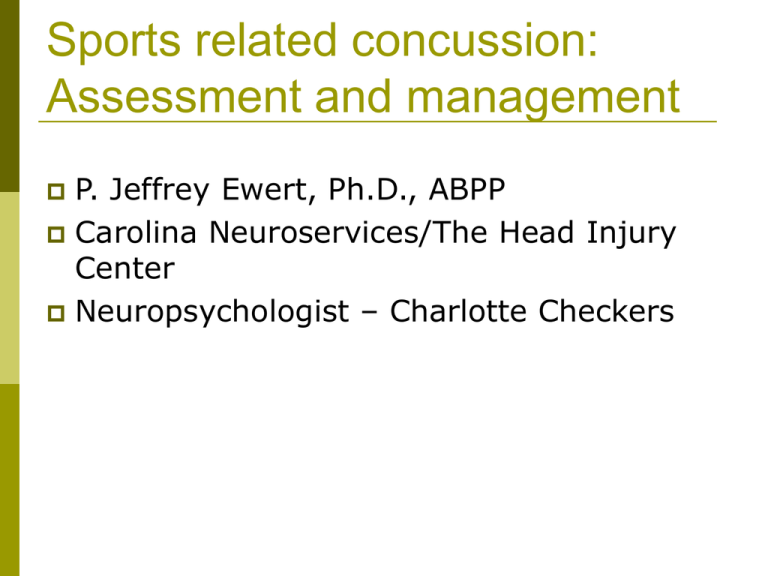
Sports related concussion: Assessment and management P. Jeffrey Ewert, Ph.D., ABPP Carolina Neuroservices/The Head Injury Center Neuropsychologist – Charlotte Checkers Definition of Concussion adopted by the NHL Caused by direct blow to the head, face, neck of shoulders with impulsive force transmitted to the head Results in rapid onset of short-lived impairment that usually resolves rapidly Neuropathological changes may result, but results are usually functional, not structural Results in a graded set of clinical symptoms that doesn’t definitely cause uncsness. Resolution of symptoms typically take sequential course, but some cases are prolonged No structural changes seen on neuroimaging Observable Concussion Signs Loss of consciousness Slow to get up following hit Motor incoordination/balance problems Blank or vacant look Disorientation Clutching of head after hit Visible facial injury in combo with any of above Concussion symptoms (player reported) Headache Dizziness Balance or coordination problems Nausea Amnesia for events around injury Cognitive slowness Photo/phonosensitivity Disorientation Visual disturbance Tinnitus Incidence 1990s - 300,000 in United States 2000s - 1.6-2.3 million One-half of sports concussions go unrecognized 90% of sports concussions have no loss of consciousness Assessment SCAT2 -Used for serial testing -Contains both symptom checklist and cognitive evaluation Computerized neurocognitive testing -ImPact -Headminder Neuropsychological testing -Specific tests vary, but have better reliability NHL postconcussion battery Baseline ImPact testing Postinjury ImPact testing and neuropsychological testing Testing repeated once a week, until player returns to baseline and is asymptomatic upon rest and exertion (both cognitive and physical) Post Injury Management No return to play if symptomatic Limited cognitive/physical exertion when symptomatic Graded increase in exertion over time Adolescents take longer to recover (13-15) and should be monitored more closely Neuropsychological testing recommended in 3 weeks if not returned to normal Balance testing recommended if not returned to normal Academic Accommodations Homebound instruction if student cannot manage school Limit homework, reading assignments Make tests multiple choice due to memory impairment Only one test per day Provide teacher notes Return to school first part-time, then increase to full-time, dependent upon mental stamina, memory and concentration Untimed tests Separate testing environment Preferential seating Gfeller-Waller Concussion Awareness Act All coaches, school, nurses, athletic directors, students and parents receive concussion and head injury information each year Athletes exhibiting signs or symptoms consistent with a concussion injury shall by removed from play or practice and not return to participation until cleared by a medical professional Each school must develop an emergency action plan to deal with serious injuries. Plan must be in writing and reviewed by an athletic trainer certified in NC and approved by the principal Schools must maintain complete and accurate records of compliance Controversies (of course) Randolph and Kirkwood (2009) PERMANENT BRAIN INJURY OR DEATH Over last 10 seasons in American football, 50 cases of permanent disability and 38 deaths Majority of deaths from subdural hematomas Risk of permanent injury is 1 per 20,500 player seasons (per year) Squad of 100 football players, 1 injury every 205 seasons Controversies cont. SECONDARY IMPACT SYNDROME Only 17 reported cases, 5 involved repeat injury. All repeat injuries within 7 days Recent study of 18 cases found thin layer of subdural hematomas in all cases Underlying vulnerability causes this outcome, possibly calcium channel subunity gene mutation (familial hemiplegic migraine) Delayed swelling found in children after 1 injury in 16% of cases, that were not sports related Only 1 case of delayed swelling in American football in last 10 years Controversies (cont) SAME SEASON REPEAT CONCUSSIONS 2 studies indicate risk of same season concussions is the same for repeat concussions as it is for single concussions (3-6%) LATE LIFE CONSEQUENCES OF REPEAT CONCUSSIONS Cognitive reserve ( more education, higher cognitive demands of employment and increased physical and mental activity during aging) delays neurodegenerative disorders Cognitive reserve decreased by multiple concussions and subconcussive blows Possible increase in DAT in retired NFL players related to concussion Conclusions CT/MRI imaging important to rule out hematomas Prolonged recovery requires a NP eval to rule out coexisting conditions, including malingering Computerized testing is not enough, due to limited reliability. ImPact is only a tool, and does not replace an experienced clinician, and treatment team.

